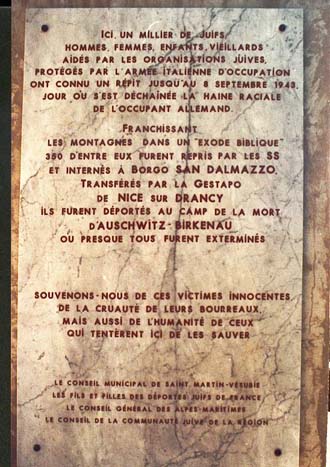This is the main city of the upper Vésubie valley. From there you can go to the Boréon, the Madonne de Fenestre, the Gordolasque valleys to hike in the mountains of the National Park of the Mercantour. You will find shops to buy food, have a drink...
Paragliding, canyoning, via ferrata... you can do this and much more in St Martin Vésubie.
If you plan to hike several days in the Vésubie valley, St Martin is a good place to stay. There are 2 campings, B&B, hotels, a parking for camping cars.
To find a room in some of these places click here.
On your way, you will see the advertising for the Alpha Park and its wolfes, located in the Boréon. According to us, there is no point visiting it.
The tourist office of course has a site with a different opinion.
St Martin Vésubie and the Jews.
During WWII, the Maritime Alps were occupied by the Italians from 1941 on. Mussolini didn't kill Jews like the nazis. Italians refused to hand jews, even foreign ones to the Germans. But foreign jews had to live in St Martin Vésubie or the valley, which became a shelter for them.
When in 1943 Mussolini was captured and the Nazis invaded the Maritim Alps, the Jews living in St Martin escaped towards Italy using the Fenestre pass. Italian soldiers retreating through the Cerise pass also took Jews with them. The SS would capture them a few days later.
An evacuation plan for Jews living in Nice and the Vésubie had been hastily prepared by some Italians, helped by French. A boat waited for them in Genova. But the German having also invaded Italy, the boat never left.
By the end of September the SS searched the valley, looking for Jews to take them to the Excelsior hotel. A large part of the population of St Martin and the valley hid the Jews to protect them. This article (in French) of the association des Justes will give you more details.

The flooding of Oct the 2nd, 2020
That day, 50cm of water fell on St Martin in less than 24h. The water, accelerated by the steep slopes around the village (summits over 3000m high) and the huge quantity of rain destroyed everything: bridges, roads, houses, including buildings which were more then 20m over the rivers. The flow of water was so powerful that it took away the ground underneath the houses and they eventually fell in the river. More than 36 houses were destroyed that day. Two men of a rescue team were also taken along by the water who tore apart the road where they were. They are among the 5 people who died that day and were found later. 11 more people are still missing. Fortunately a red weather alert by the weather forecast service (Météo France) enabled people to be aware of an imminent danger, and probably saved lives.
Specialists consider that this event represents a millenial flooding of the Boreon and the Vesubie, the 2 rivers in this valley.
An other valley was also heavily impacted, with large destructions : roads, houses, bridges, even a cimetery whose corpses were found by dozens in the sea near Vintimiglia, in Italy, and many villages were isolated for more than 2 weeks. The Roya valley, with villages such as Breil sur Roya, Tende, St Damlas de Tende....
The TInee valley and the medium Var valley suffered also damages, but mainly road damages.

